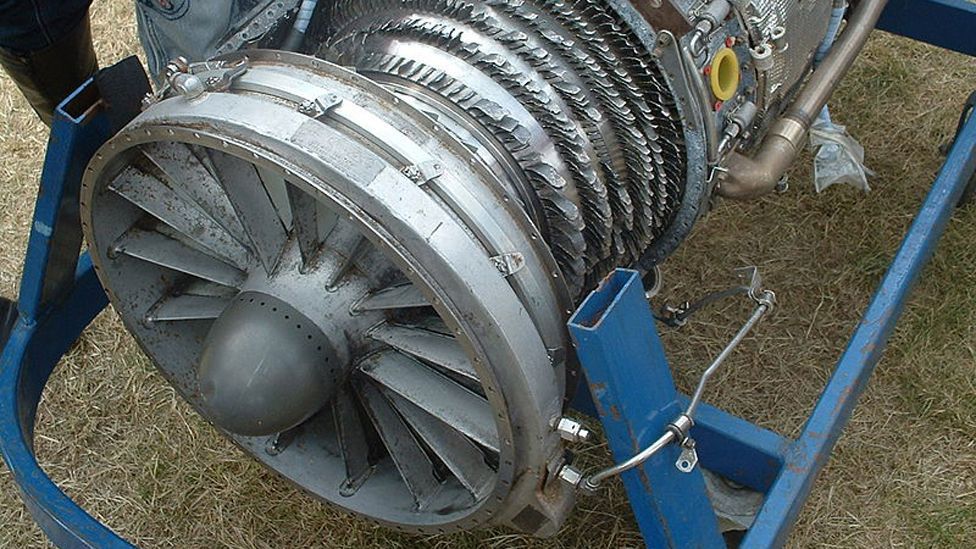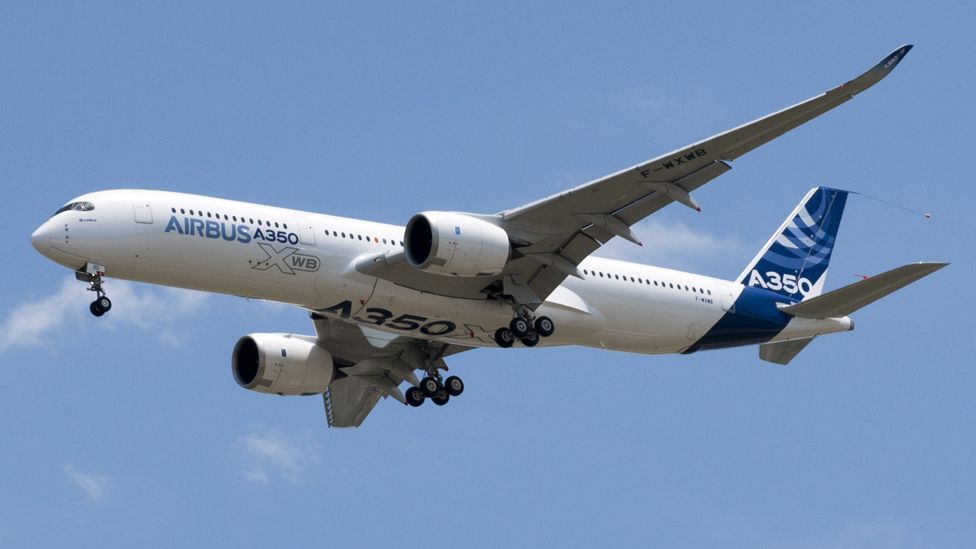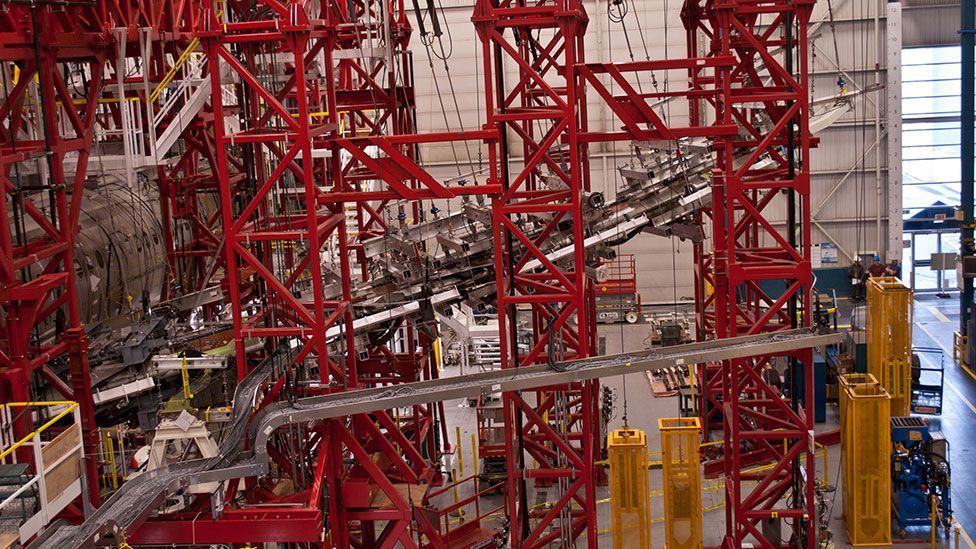Can I Put Air Lift in a Lifted Truck
The extreme tests planes become through earlier taking off

Modern airliners become through a serial of exhaustive tests, from the earliest stages of blueprint, to make sure they are as safe every bit possible. Katia Moskvitch lifts the chapeau on some of the stresses plane-makers put them through – from Arctic freezing to shooting chickens at the cockpit.
A
Aeroplanes take moved on more than a little since the first aviators soared into the sky, clad in leather jackets, caps and goggles. Back then, they needed quite an element of faith earlier taking to their flying machines. One hundred years on, they board highly complex machines often made from unusual materials such as carbon fibre and flying partly thanks to computers. The days of flying on "a wing and a prayer" are over.
Nowadays, aircraft testing is incredibly elaborate and rigorous. New planes only make information technology into the air after a long list of tests – from chucking chickens into jet engines to simulate bird strikes to bending the wings to extreme angles.
In the last 10 years, the testing methods have undergone major changes– both on the basis and in computer simulations. The aim, in both cases, is to minimise the number of hours testing planes in flight.
Accidents of the past – such as the crash of an airliner at Dallas Fort-Worth in 1985 during a thunderstorm, or the electrical fault which brought down a TWA flight almost New York in 1996 – spurred aircraft designers to bring in more and more prophylactic features into new aircraft at the design stage, long before they started conveying paying passengers.
Angle wings
Many of us take experienced a bumpy ride on a plane, but the routine – albeit always scary –of sudden drops or wobbling wings is nothing compared to what an aircraft is subjected to when undergoing tests. Many modern passenger jets can flex their wings well-nigh 90 degrees in a exam rig.

Bombardier test the resilience of their aircraft wings at a special facility (Bombardier)
To meet how the wings and fuselage would behave under both normal and infrequent loads during their life, manufacturers perform so-called "static tests."
Airbus, for example, performed the ultimate load test on a peculiarly congenital static airframe of its A350 XWB Airbus in Dec 2013. The plane's wings received loads of up to 1.five times college than they would ever encounter in service. And at ultimate load, the airplane'due south wingtip deflection exceeded five metres – that means the load aptitude the wing upwards most 90 degrees.
The final test involves getting the aircraft wings to snap – this helps detect out their breaking point, and ensures it is well beyond the predicted load level.
Ingestion tests: birds and h2o
If an plane encounters a flock of geese on its style to warmer climes, it'south not just a bloody meet for the birds, it is also a major risk for those inside the plane. Even pocket-sized birds tin can cause an engine to stall or explode.
According to a recent written report conducted by the International Bird Strike Committee, at that place is only about i accident that results in homo death in 1 billion flight hours. Most bird strikes cause little damage to the plane – but the collision is very often fatal to the bird. And such accidents cause damage to commercial aircraft costing some $1.2bn to repair every twelvemonth.
One of the aviation pioneers, Cal Rodgers, was the get-go person to die from a bird strike. In 1912, his aircraft collided with a gull over Long Beach, California that became tangled in his plane'south control cables. Rodgers' plane crashed and he drowned.

Bird strike is often fatal for the bird - but tin be lethal for those in the aeroplane, too (Wikimedia Commons)
Bird strikes are still a cause for concern, fifty-fifty as planes become more sophisticated and resilient. On 15 Jan 2009, a United states of america Airways Airbus A320 collided with a flock of geese, and both engines were disabled. The plane ditched into New York's Hudson River in a text-book crash landing on water, with all 155 passengers and crew safe evacuating safely.
To ensure that engines continue to operate fifty-fifty afterwards a bird strike, engine manufacturers do just that: throw dead birds into test engines on the ground with a so-called "chicken gun"– a large-diameter, compressed-air cannon. The craven gun was invented in the 1950s by de Havilland in the UK; freshly killed chickens were packed into a compressed air gun and fired at the windscreen and engines. Shipping manufacturers likewise simulate bird strikes at cockpits, likewise using the gun to propel birds onto a windshield, to ensure that it won't suspension the plane'south windows or change the way it flies.
"We have used fowl to test shipping structures," says Adam Tischler, of Boeing'southward Flight Test Communications Segmentation. "This is not a common test, however information technology can be an constructive way to evaluate the results of a bird strike on an aircraft."
Water can be some other consequence. To exam what happens when large amounts of water get into the engine, for example in case of heavy rain, planes taxi through a specially made water trough. "These tests assess the correct functioning of engines and thrust reversers, as well as braking systems, when submitted to water thrown upward past the wheels in cases of continuing water on the runway," says Justin Dubon of Airbus. Other tests, such as those which Boeing undertakes, forcefulness a steady stream of water or burn down loosely compacted ice into the engines to mimic the effects of cruising through a hail deject.
Hot and common cold tests
To make certain engines, systems and materials piece of work properly under extremely hot temperatures and at high distance, manufacturers stage a "hot and high campaign"– to test shipping in intense heat and freezing conditions.
For example, to examine the latest Airbus A350 XWB'due south ability to withstand freezing temperatures, the aeroplane manufacturer's engineers took it to Iqaluit, the capital of Canada'south Arctic territory of Nunavut. It stayed at that place for a week, and the tests included operating the plane on the ground and in the air in temperatures as low as -28C (-18F) and performing thrust-reversed tests with snow – basically, the effects of sudden braking that you might discover on an aborted accept-off. The trials also include powering-up the aircraft afterwards long periods at depression temperatures, says Dubon.

Airbus's test A350 has undergone many rigorous tests - including Arctic freezing (Wikimedia Commons)
Planes too spend most a week carrying out like tests at high altitude airfields like Cochabamba and La Paz (Bolivia), Addis Ababa (Ethiopia) and others. La Paz is ane of the globe'south highest airports at xiii,300ft (4km) to a higher place ocean level, and Cochabamba is at around 8,300ft (2.5km) feet.
Using a plane at such high altitude airfields puts a huge strain on the engines and other systems. To test that everything operates smoothly, tests include several have-offs with all engines operating and with simulated engine failures, and the autopilot behaviour during automatic landings and go-arounds (aborted landings) is also checked. "The aim of such trials is to validate full functionality of the engines, systems, materials... and to ensure that the passengers, if always in this scenario, are always in a comfortable environment," says Dubon.
Air current tunnels, meanwhile, permit manufacturers to test all phases of flight – including farthermost weather condition. For instance, Boeing conducts tests at its Research Aerodynamics Icing Tunnel (Brait), says Adam Tischler, of Boeing's Test & Evaluation department. Information technology's in there that the company inserts a cross department of a wing to test de-icing systems. The tunnel tin examination speeds betwixt 60 and 250 knots (110kp/h to 463kp/h) in temperatures as low as -40C (-40F), says Tischler. The facility allows Boeing to simulate many kinds of rain, ice and cloud conditions that aeroplanes might run across.
Virtual airplane: Iron Bird
One of the most cut-edge ways of testing mod planes involves building the guts of the shipping on the ground and then testing these systems digitally. Bombardier, for instance, has built a footing testing facility called "Aircraft Zero" (Complete Integrated Aircraft Systems Test Area or Ciasta) in Montreal. Information technology's basically a rig that has all the key systems of a typical aeroplane. Information technology is used "to simulate an aircraft in flight virtually even before the actual shipping takes to the sky" says Bomardier'south Sebastien Mullot.
The simulation uses high tech full aircraft system layouts on the ground called Iron Birds. "Iron-birds tin can simulate all flight segments such as accept-off, prowl, landing, and and so on, then that the aircraft is virtually tested on 'real' flights such as London to Dubai without any actual flight taking place," says Mullot. "All this tin can be done well before the starting time pieces of the commencement aircraft to fly are assembled."
The simulation helps anticipate whatsoever potential structural issues such every bit miniature cracks that could announced at a specific point of an aircraft's service life, says Mullot.
It is even possible to virtually test for bird strikes on the cockpit and on the wing'southward leading border. "We can predict the structure behaviour according to any weight of the bird and whatever bear upon bespeak," says Jean-Louis Montel, deputy head of the blueprint office at Dassault Aviation, a French aircraft maker. "This way, during the real test, a 'calibrated' bird is used and merely critical touch on points are tested."
Engineers besides carry out ultrasound tests on where the wing meets the fuselage; information technology allows to look inside the textile and discover possible defects without having to take the airplane apart.
Lightning tests
On average, every commercial plane is hit by lightning about one time a year, according to the Cardiff University'south "lightning lab" in the UK – a recently established laboratory where Airbus, for example, conducts lightning tests. The university's lab is formally called the Morgan Botti Laboratory at the School of Engineering.

The wings are pulled up on a special rig until they fissure under the strain (Bombardier)
Despite lightning strikes, traditional aluminium planes are unremarkably able to continue their journey safely – the high electrical conductivity of aluminium can dissipate the electricity through the aircraft structure chop-chop without causing any impairment. Just not all planes are made from metal anymore: to reduce weight and therefore fuel consumption, next-generation aircraft are built from new and much lighter materials such as carbon fibre, which tend to have much lower electrical conductivity than aluminium, says Airbus'south Matthew Cole.
This can lead to upward to 25% improvement in fuel efficiency. These materials, however, demand to exist protected against lightning strike. Information technology is usually done by adding a sparse layer of metal mesh or foil. "This layer is safe and effective and successfully dissipates the charge, mitigating damage," says Cole. The problem, though, is that information technology adds weight.
At Cardiff's lightning lab, researchers are looking for other solutions to protect systems against strikes, while maintaining safety levels and without adding weight. The work involves "putting panels through lightning strike tests to ameliorate empathise the reaction of dissimilar materials," says Cole. Discharges tin can exist upwards to 100,000 amps – enough to ability a small town.
At Boeing, there are 2 different systems to test for lightning. Ane is a two megavolt high voltage generator that produces a lightning "strike" indoors and can mimic where the lightning will attach on an airplane in flying. The 2nd organisation is a 50-threescore kilovolts high current organization that tin can output 200,000 amps to simulate a powerful strike on the plane's skin.
We've come up a very long manner since the early on 1950s, when the early commercial jet liners such as United kingdom'southward pioneering Comet suffered serious issues, some of them resulting in fatal crashes. Ever since, aircraft manufacturers have been searching for always more sophisticated ways for testing their planes. Then side by side time you lot encounter turbulence or bad atmospheric condition on a flying, exist assured that your airplane has survived much worse.
If yous would like to annotate on this, or anything else yous take seen on Future, caput over to our Facebook or Google+ page, or message us on Twitter .
hernandeztesto1985.blogspot.com
Source: https://www.bbc.com/future/article/20140319-stress-tests-for-safer-planes
0 Response to "Can I Put Air Lift in a Lifted Truck"
Post a Comment